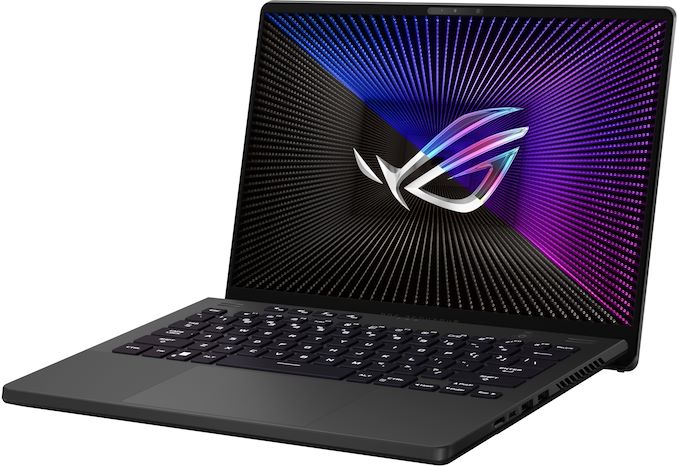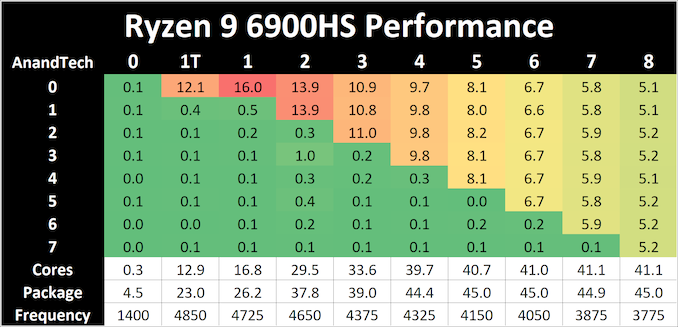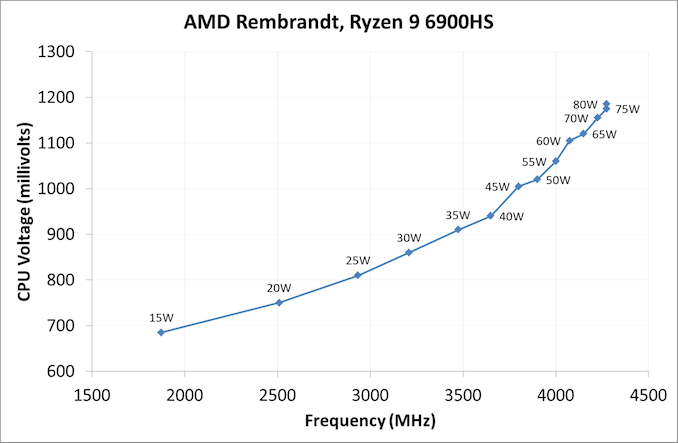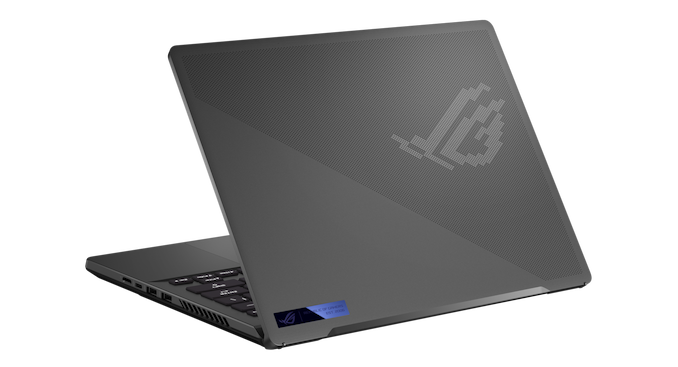AMD's Ryzen 9 6900HS Rembrandt Benchmarked: Zen3+ Power and Performance Scaling
by Dr. Ian Cutress on March 1, 2022 9:30 AM ESTConclusion
When AMD announced the new Ryzen 6000 Mobile series, codename Rembrandt, we saw a number of distinct upgrades over the previous generation: moving from TSMC 7nm to TSMC 6nm should provide a small efficiency boost, and then coupled with the move from DDR4 to DDR5 should greatly improve any memory-bound workloads. Instead of Vega graphics we now move to RDNA2 graphics, which should provide a much better gaming experience, coupled with that increased memory bandwidth. On top of that all, we were told about AMD’s 50+ updates to the SoC focused on power management, wake from sleep, and race to sleep. The one thing that we knew didn’t change was the CPU core: despite being called Zen3+, there is no difference in the microarchitecture compared to Zen3 – the reason why it gets a plus is due to the power management techniques, improved memory, and new manufacturing process.
But the fact of the matter is, CPU performance is more than just the microarchitecture and frequency. Beyond that, it’s the memory subsystem, which also contributes directly to IPC or performance per clock. This is why I’ve gone off iso-frequency testing for this sort of comparison, because each product is built with optimization points in mind, and moving simply the core frequency causes a different balance of resources compared to the ‘as built’ and ‘as sold’ metrics. This is why when we put Zen3+ up against Zen3 at a similar power level, we’re seeing a sizable uptick in performance.
In our industry standard SPEC tests, this translates to an +11.9% average increase for Zen3+ across integer and floating point in single threaded mode compared to Zen3. In multi-threaded mode at 35 W, this was a +10.4% for integer, but +32.4% for floating point. We saw a similar size jump in our multi-threaded floating point SPEC tests when Intel’s Alder Lake moved from DDR4 to DDR5, showcasing that there are key industry standard workloads for which DRAM memory bandwidth is still the limiting factor.
So while it’s a great move to see AMD jump into DDR5 with this new platform, the elephant in the room is still the performance against similar power hardware from Intel. Unfortunately we don’t have too many data points, as Brett in Canada tested the performance-focused 12900HK, and I’m the UK where I tested the efficiency-focused 6900HS, but suffice to say that in raw performance at least, comparing P cores to Zen3+ and multi-threaded workloads, Intel still has an advantage. Intel’s advantage increases when we increase the power, as it seemingly has more frequency to give, whereas AMD’s Rembrandt is already near peak all-core frequency at modest 35-45W power levels. This is showcasing one difference between the two manufacturing processes: AMD on TSMC N6, and Intel on Intel 7.
If we take something as simple as CineBench R20 (everyone’s favorite), the Intel CPU in 45 W mode scores 730, while the AMD CPU in 45 W mode scores 613, only matching Intel’s previous generation. That’s partly due to the single threaded power consumption on both platforms – while AMD is using 12.9 W on the cores (23 W package) to reach one thread at 4850 MHz, and doesn’t improve single thread performance in higher power modes, Intel does gets a performance uplift going from 45 W to 65 W, suggesting that the single thread power consumption is up in that region.
The same applies for multi-threading – in a lot of our benchmarks we see that AMD scores minor gains going from 35 W to 45 W to 65 W, indicating that the efficiency point is really around that 35 W metric. But when we scale that up to the multi-threaded tests, Intel can scale power for additional performance a lot more, but also wins as it has a total of 20 threads, compared to AMD’s sixteen. This means at the end of the day Intel can get +40% performance at the same power in benchmarks that can take advantage of its core structure, but only +14% in other tests (like SPEC) despite having +25% more cores.
While we haven’t touched battery life or graphics in this article, instead looking at CPU performance, we can see that realistically AMD is finding a good optimization point around that 35 W mark with this new Rembrandt chip. Pushing for more power gives minor performance uplifts, suggesting it isn’t really that scalable, but when we combine the new updated SoC with the move to DDR5, it’s still a great performer. In fact, both Intel and AMD chips seem to be amazing this generation, and if you’re in the market for a flagship, CPU performance is everywhere. But right now, Intel seems ahead at the high-end.
What’s going to be interesting here is testing the 15 W versions of the latest platforms. AMD still has 8 core processors, with all 8 cores being big cores, whereas Intel has moved down to 2 big cores paired with 8 efficient cores. We might see the tides shift the other direction allowing AMD to be more scalable, pushing 15 W or higher modes with more performance, while Intel relies on the efficient cores to pick up the rest of the workload. Ultimately this is where the battle really matters, as this is at the price points where most notebooks are going to be sold.
















92 Comments
View All Comments
yankeeDDL - Tuesday, March 1, 2022 - link
Great article, as usual.It seems clear that Intel's AL still has the performance advantage, however, in the Conclusion page, the performance comparison is reference to the nominal consumption (35W, 45W, 65W), while we know that Intel's part can reach twice as much power, in practice, making an apples-to-apples comparison quite difficult, especially in light of Intel's better scaling with more Power.
Is there a way to check the exact performance per core under the same exact consumption (or scaled)?
I am especially interested as a user of the 1165G, which is an absolute battery eater (and/or heater): it seems that AL is a huge improvement, but if it also draws 100W (instead of 45W) to beat Ryzen by a 10%, then it's not worth it. In my opinion.
Spunjji - Tuesday, March 1, 2022 - link
Yes, the overall picture that has built up is of Intel's Alder Lake winning out at higher power levels (40W+) while AMD coming out ahead below that.This is good, because it means that we have great options for people who want the best possible performance in a mobile form-factor and for people who want a more even balance of performance and power usage. It's a nicer situation to be in than when Intel complete owned the mobile segment, followed by the years of stagnation at 14nm.
yankeeDDL - Tuesday, March 1, 2022 - link
Agree on all points.Intel's Tiger Lake is an absolute disaster, and it is actually surprising that Intel only managed to lose 50% market share with such a lousy product compared to Ryzen.
And equally surprising is the insane jump in performance and perf/watt achieved with AL. Definitely good for the consumers.
mode_13h - Tuesday, March 1, 2022 - link
> Intel's Tiger Lake is an absolute disasterThat seems like an overstatement. It just didn't improve enough against Ryzen, particularly in light of the 5000-series' gains. However, especially in light of Ice Lake's disappointments, Tiger Lake didn't seem so bad.
Alistair - Tuesday, March 1, 2022 - link
Tiger Lake was a stroke of luck for Intel, their worst product ever during a massive silicon shortage. They spent the year selling quad cores because AMD was selling everything they could make, not because Tiger Lake was any good.bigboxes - Wednesday, March 2, 2022 - link
For sure. I went with AMD for the first time since 2006 this last year.Samus - Thursday, March 3, 2022 - link
The irony here is AMD mobile CPU's are widespread in lots of desktops and AIO's, even high end units. You would rarely, if ever, see Intel U-series parts in desktops\AIO's outside of USFF's or low-end AIO's with Celeron\Pentiums.This is happening partially because AMD doesn't have a wide product stack like Intel. And they don't need too. The AMD U-series parts are absolute performance monsters and have been for the last 3 generations.
abufrejoval - Friday, March 4, 2022 - link
I own both, a Ryzen 5800U in a notebook and an i7-1165G7 as a NUC.They are really quite comparable, both in iGPU performance, in scalar CPU power and even in multi-threaded CPU power.
At 15 Watts the 8 Ryzen cores operate below the CMOS knee, which means they have to clock so low they can't really gain much against 4 Tiger Lake cores clocking above it. Synthetic benchmarks may prove a lead that's next to impossible to realize or really relevant in day-to-day work. For the heavy lifting, I use a 5950X, which isn't that much faster on scalar loads, but runs almost as many rings around the 5800U as the i7-1165G7: the extra Watts make more of a difference than the cores alone.
My impression is that the Ryzen needs the higher power envelope, 35 or even 65 Watts, and of course a matching workload to put those extra cores to work. AMD's primary aim for their APUs was to cover as many use cases as possible from a single part and they do amazingly well. If they could afford to do a native 4 core variant as well, I'm pretty sure that would outsell the 8 core.
In fact the SteamDeck SoC would probably make a better notebook part for many (not everyone).
And there is nothing wrong with Tiger Lake, except that perhaps today there are better SoCs around: it was and remains a welcome improvement over the previous generations from Intel.
Buy it used and/or cheaper than these AL parts and you should have little to complain about... unless complaining is what you really enjoy.
mode_13h - Tuesday, March 1, 2022 - link
> Great article, as usual.I thought so, as well, which was a relief. Then, I noticed the by-line:
"by Dr. Ian Cutress"
lemurbutton - Tuesday, March 1, 2022 - link
People shouldn't care that much about AMD and Intel on laptops right now. M1 series completely destroys both. AMD and Intel are 3-4 years behind.